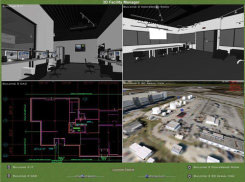Chiron Portal Taps Virtual World: Desktop application helps users display 3D
Chiron Technology Services, Inc. has developed a portal that gives users an easy way to display and interface with different datasets that it has created in a serious gaming environment.
With serious gaming, information is presented with the look and feel of a video game, but offers a deeper experience: It helps a soldier prepare for battle by showing real-life battlefield scenarios or gives a facilities manager a 3D view of the buildings he manages.
Chiron uses Autodesk software to develop virtual environments for its users, many of whom are in the intelligence and Defense communities. The company’s new desktop application offers an easy interface to the data stored in these 3D environments.
“The whole reason why we decided to build a portal is because there were no applications out there that could ingest and display all the different types of datasets we were creating using Autodesk tools,” said Jeff Weaver, vice president of business development at Chiron.
“The nice thing is that the Autodesk tools really democratize the data creation side of it,” Weaver said. “We can quickly create datasets, but had no place to put them. The idea is to create an interface…and leave it up to the user on how to use it. It’s always going to be data driven.”
“A user can, through a simple executable on the desktop, launch an interface that will reach back to a database,” said Jack Farmer, director of serious gaming at Chiron. “We try to make it as seamless as possible and as non-intensive on end users’ machines as we can.”
The end users benefit from this approach. “Let’s say there is an explosion and you wanted to see what the effect on the area would be if a strong wind comes blowing in,” Farmer said. “Data fusion allows users to exploit the data for mission planning, and also for training. Once we create the scene and load it within the viewer/portal, the built-in tools and the database connectivity are available. Users can then exploit the data as they see fit.”
What also makes the application unique is who it’s developed for. “A lot of other gamers deal with gaming,” Farmer said. “We’re dealing with the intel community. We have a different mission. And because we work on government machines we don’t want to install new software. We try to be as agnostic as possible.”
Not only has Chiron made advances in application development, but it has also developed improved workflow analysis that compresses the amount of time that it takes government users to analyze the data and deliver it to decision makers, Weaver said.
 “We have around a dozen workflows that have taken the analysis time of different types of data down to a third or even less,” Weaver said. In one instance, analysis that took a month now takes a day and a half. Our services team works with our clients to develop these workflows. It’s a process change.”
It’s easier now to conduct analysis that wasn’t happening before. “We’ve seen a lot of analysis wasn’t being done because it took too long,” Weaver said. “It wouldn’t be done in time to be useful. We create workflows to help satisfy requirements. That’s the strength of the Autodesk tools. We’ve learned that if you put simple tools in clever analysts’ hands, they do great things.”
Chiron Technology Services Inc. has already put its new portal application to use. The company worked with the Democratic and Republican National Conventions to help police, security and first responders visualize the buildings where the conventions were held to keep people safe.
Chiron acquired the architectural plans for Denver’s Pepsi Center, where the DNC was held in August, as well as the plans for the Xcel Energy Center in Minneapolis-Saint Paul where the Republican convention was held in September.
“From the data we created 3D models within a gaming environment so people that were working there could get the lay of the land and walk the building before they get there,” said Jack Farmer, director of serious gaming at Chiron. “We used Revit Architecture, AutoCAD® Structure and Map 3D to bring in all the data we could,” Farmer said.
In addition, analysis tools allowed them to virtually put themselves in a particular point in the building, which is useful for counter sniper points, and measure how long it would take for a vehicle to travel from the airport to the arena without actually having to drive it. “Our feedback from the customer is we’re allowing them to do things they couldn’t do before because they didn’t have the manpower,” said Jeff Weaver, vice president of business development at Chiron.
“We have around a dozen workflows that have taken the analysis time of different types of data down to a third or even less,” Weaver said. In one instance, analysis that took a month now takes a day and a half. Our services team works with our clients to develop these workflows. It’s a process change.”
It’s easier now to conduct analysis that wasn’t happening before. “We’ve seen a lot of analysis wasn’t being done because it took too long,” Weaver said. “It wouldn’t be done in time to be useful. We create workflows to help satisfy requirements. That’s the strength of the Autodesk tools. We’ve learned that if you put simple tools in clever analysts’ hands, they do great things.”
Chiron Technology Services Inc. has already put its new portal application to use. The company worked with the Democratic and Republican National Conventions to help police, security and first responders visualize the buildings where the conventions were held to keep people safe.
Chiron acquired the architectural plans for Denver’s Pepsi Center, where the DNC was held in August, as well as the plans for the Xcel Energy Center in Minneapolis-Saint Paul where the Republican convention was held in September.
“From the data we created 3D models within a gaming environment so people that were working there could get the lay of the land and walk the building before they get there,” said Jack Farmer, director of serious gaming at Chiron. “We used Revit Architecture, AutoCAD® Structure and Map 3D to bring in all the data we could,” Farmer said.
In addition, analysis tools allowed them to virtually put themselves in a particular point in the building, which is useful for counter sniper points, and measure how long it would take for a vehicle to travel from the airport to the arena without actually having to drive it. “Our feedback from the customer is we’re allowing them to do things they couldn’t do before because they didn’t have the manpower,” said Jeff Weaver, vice president of business development at Chiron.
 By Colleen O’Hara, Reporter, [acronym] magazine
Originally published in [acronym] magazine, Issue 9
Bios:
By Colleen O’Hara, Reporter, [acronym] magazine
Originally published in [acronym] magazine, Issue 9
Bios:
 Jeff Weaver is Vice President for Business Development with Chiron Technology Services and has over 16 years experience serving the U.S. Intelligence Community, Air Force and other DoD elements.
Jack Farmer, Director of Serious Gaming, Chiron Technology Services, has over eight years of experience delivering creative visualization solutions
Jeff Weaver is Vice President for Business Development with Chiron Technology Services and has over 16 years experience serving the U.S. Intelligence Community, Air Force and other DoD elements.
Jack Farmer, Director of Serious Gaming, Chiron Technology Services, has over eight years of experience delivering creative visualization solutions  the U.S. Intelligence Community.
the U.S. Intelligence Community.
 “We have around a dozen workflows that have taken the analysis time of different types of data down to a third or even less,” Weaver said. In one instance, analysis that took a month now takes a day and a half. Our services team works with our clients to develop these workflows. It’s a process change.”
It’s easier now to conduct analysis that wasn’t happening before. “We’ve seen a lot of analysis wasn’t being done because it took too long,” Weaver said. “It wouldn’t be done in time to be useful. We create workflows to help satisfy requirements. That’s the strength of the Autodesk tools. We’ve learned that if you put simple tools in clever analysts’ hands, they do great things.”
Chiron Technology Services Inc. has already put its new portal application to use. The company worked with the Democratic and Republican National Conventions to help police, security and first responders visualize the buildings where the conventions were held to keep people safe.
Chiron acquired the architectural plans for Denver’s Pepsi Center, where the DNC was held in August, as well as the plans for the Xcel Energy Center in Minneapolis-Saint Paul where the Republican convention was held in September.
“From the data we created 3D models within a gaming environment so people that were working there could get the lay of the land and walk the building before they get there,” said Jack Farmer, director of serious gaming at Chiron. “We used Revit Architecture, AutoCAD® Structure and Map 3D to bring in all the data we could,” Farmer said.
In addition, analysis tools allowed them to virtually put themselves in a particular point in the building, which is useful for counter sniper points, and measure how long it would take for a vehicle to travel from the airport to the arena without actually having to drive it. “Our feedback from the customer is we’re allowing them to do things they couldn’t do before because they didn’t have the manpower,” said Jeff Weaver, vice president of business development at Chiron.
“We have around a dozen workflows that have taken the analysis time of different types of data down to a third or even less,” Weaver said. In one instance, analysis that took a month now takes a day and a half. Our services team works with our clients to develop these workflows. It’s a process change.”
It’s easier now to conduct analysis that wasn’t happening before. “We’ve seen a lot of analysis wasn’t being done because it took too long,” Weaver said. “It wouldn’t be done in time to be useful. We create workflows to help satisfy requirements. That’s the strength of the Autodesk tools. We’ve learned that if you put simple tools in clever analysts’ hands, they do great things.”
Chiron Technology Services Inc. has already put its new portal application to use. The company worked with the Democratic and Republican National Conventions to help police, security and first responders visualize the buildings where the conventions were held to keep people safe.
Chiron acquired the architectural plans for Denver’s Pepsi Center, where the DNC was held in August, as well as the plans for the Xcel Energy Center in Minneapolis-Saint Paul where the Republican convention was held in September.
“From the data we created 3D models within a gaming environment so people that were working there could get the lay of the land and walk the building before they get there,” said Jack Farmer, director of serious gaming at Chiron. “We used Revit Architecture, AutoCAD® Structure and Map 3D to bring in all the data we could,” Farmer said.
In addition, analysis tools allowed them to virtually put themselves in a particular point in the building, which is useful for counter sniper points, and measure how long it would take for a vehicle to travel from the airport to the arena without actually having to drive it. “Our feedback from the customer is we’re allowing them to do things they couldn’t do before because they didn’t have the manpower,” said Jeff Weaver, vice president of business development at Chiron.
 By Colleen O’Hara, Reporter, [acronym] magazine
Originally published in [acronym] magazine, Issue 9
Bios:
By Colleen O’Hara, Reporter, [acronym] magazine
Originally published in [acronym] magazine, Issue 9
Bios:
 Jeff Weaver is Vice President for Business Development with Chiron Technology Services and has over 16 years experience serving the U.S. Intelligence Community, Air Force and other DoD elements.
Jack Farmer, Director of Serious Gaming, Chiron Technology Services, has over eight years of experience delivering creative visualization solutions
Jeff Weaver is Vice President for Business Development with Chiron Technology Services and has over 16 years experience serving the U.S. Intelligence Community, Air Force and other DoD elements.
Jack Farmer, Director of Serious Gaming, Chiron Technology Services, has over eight years of experience delivering creative visualization solutions  the U.S. Intelligence Community.
the U.S. Intelligence Community.















































